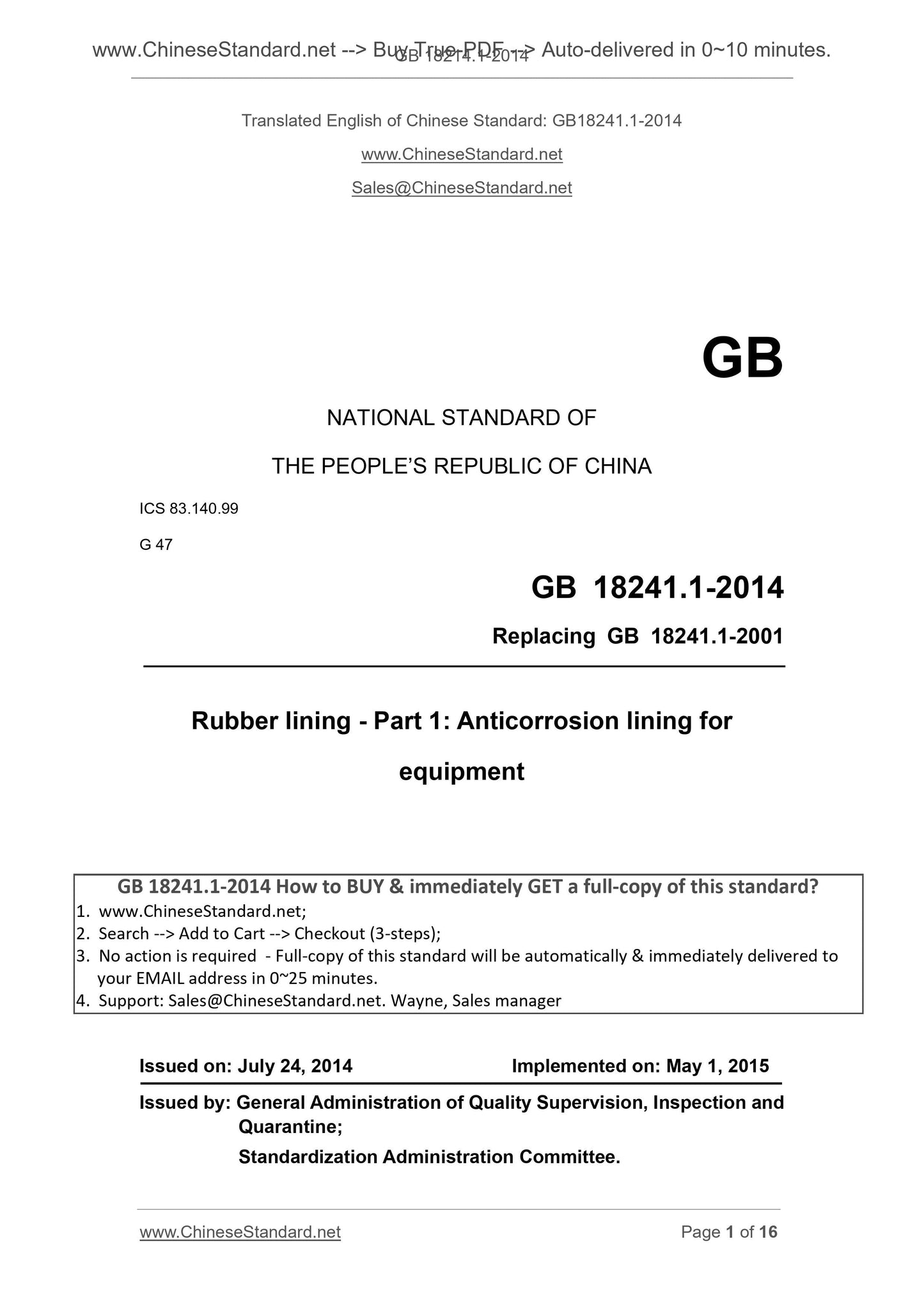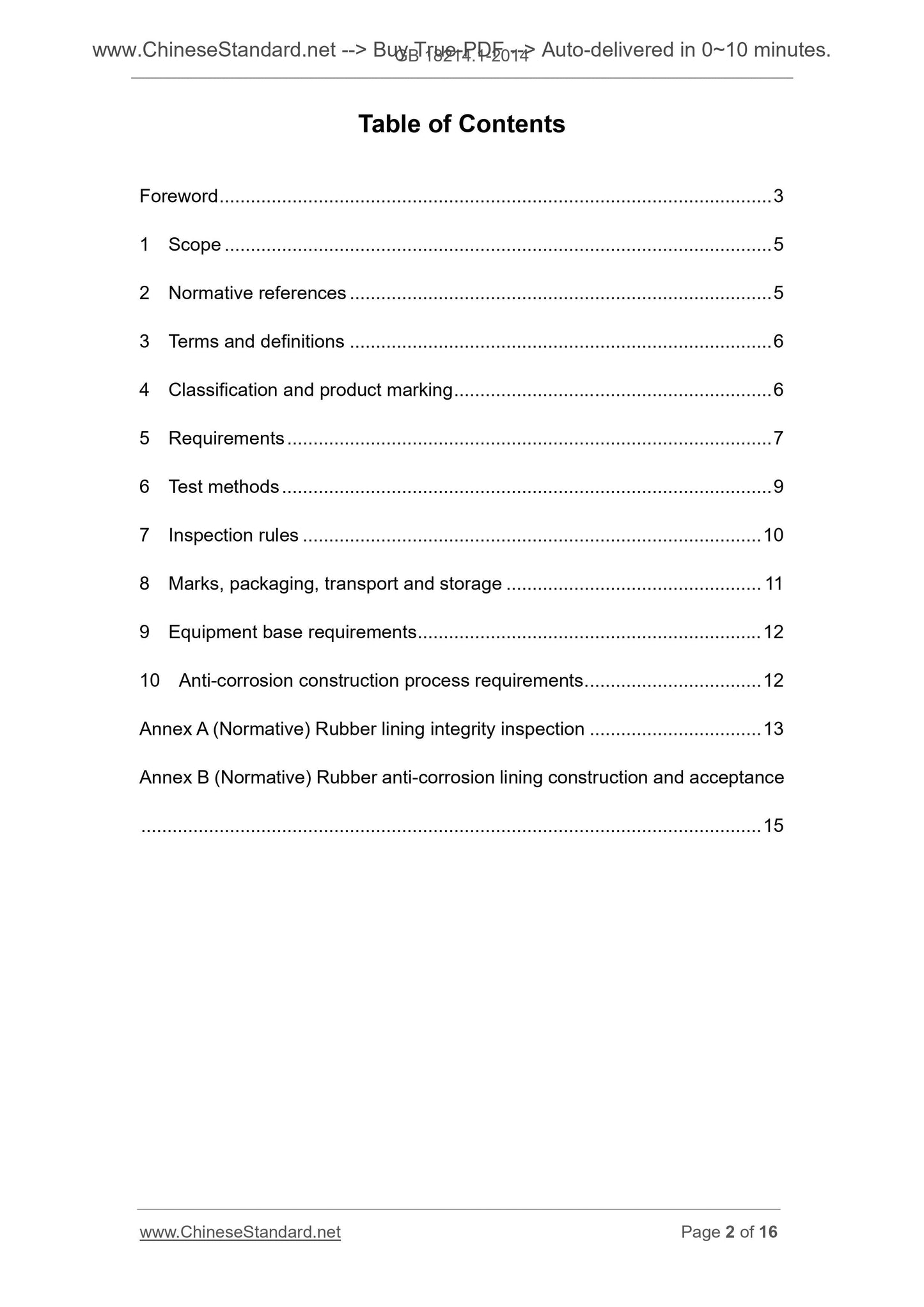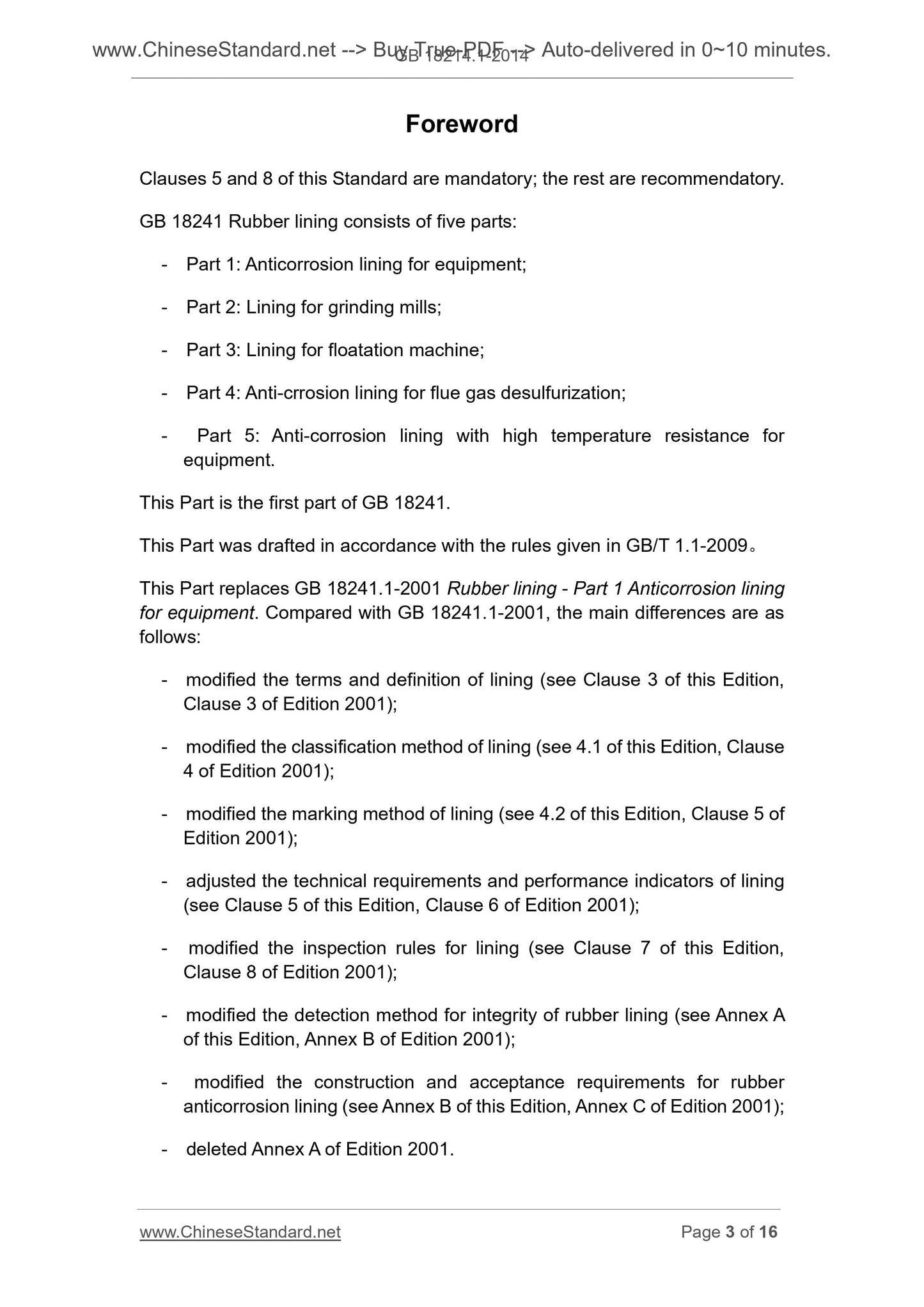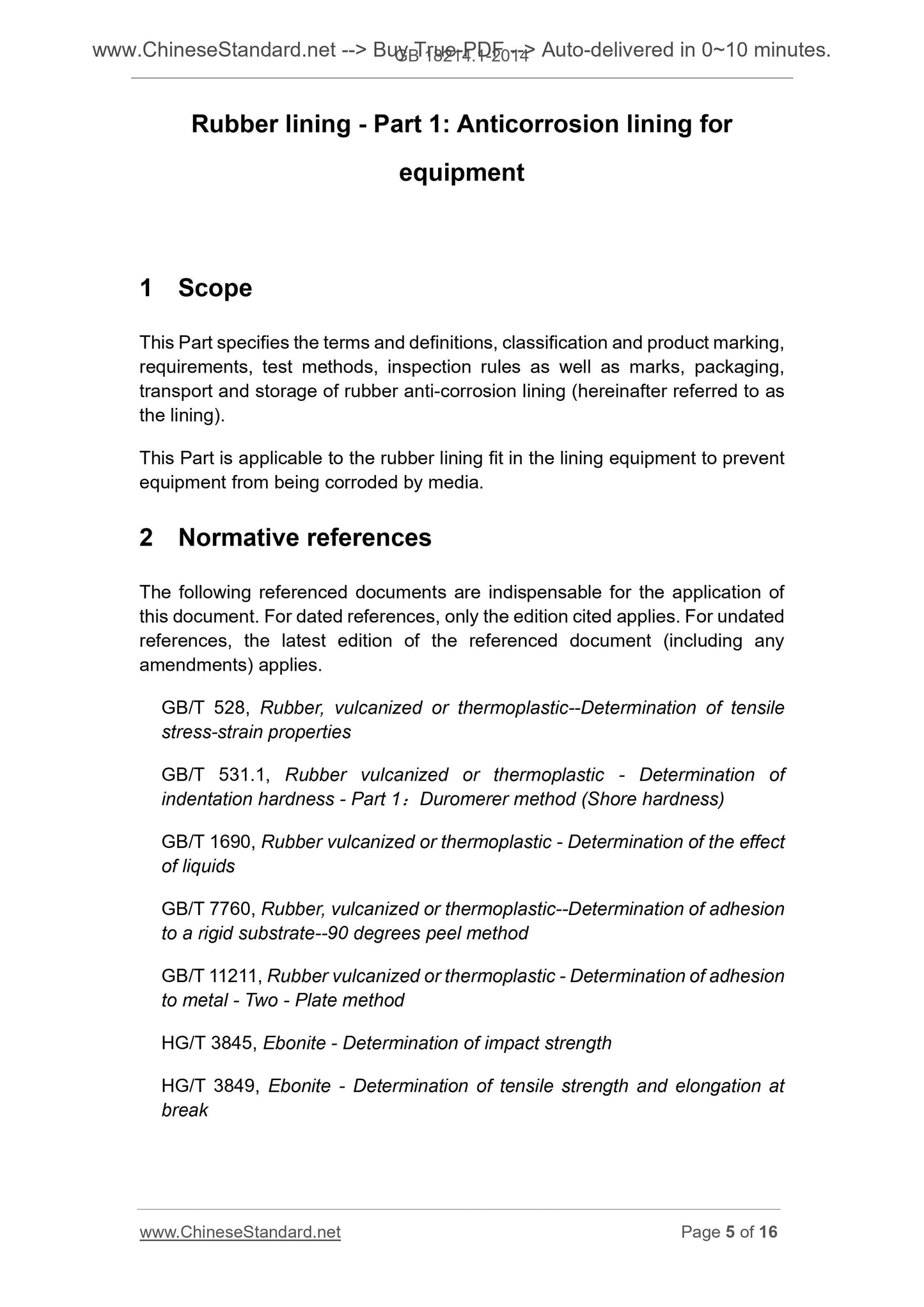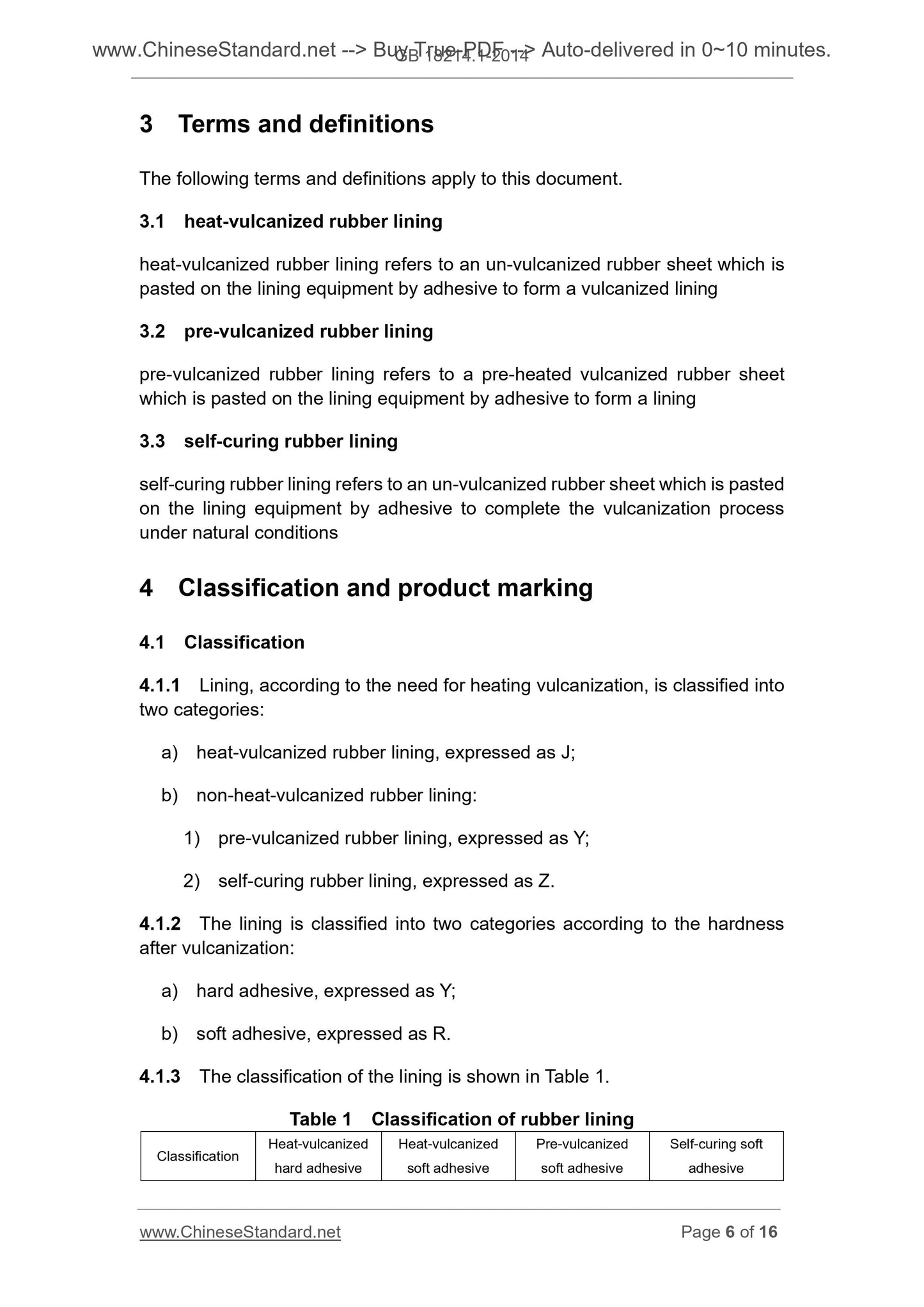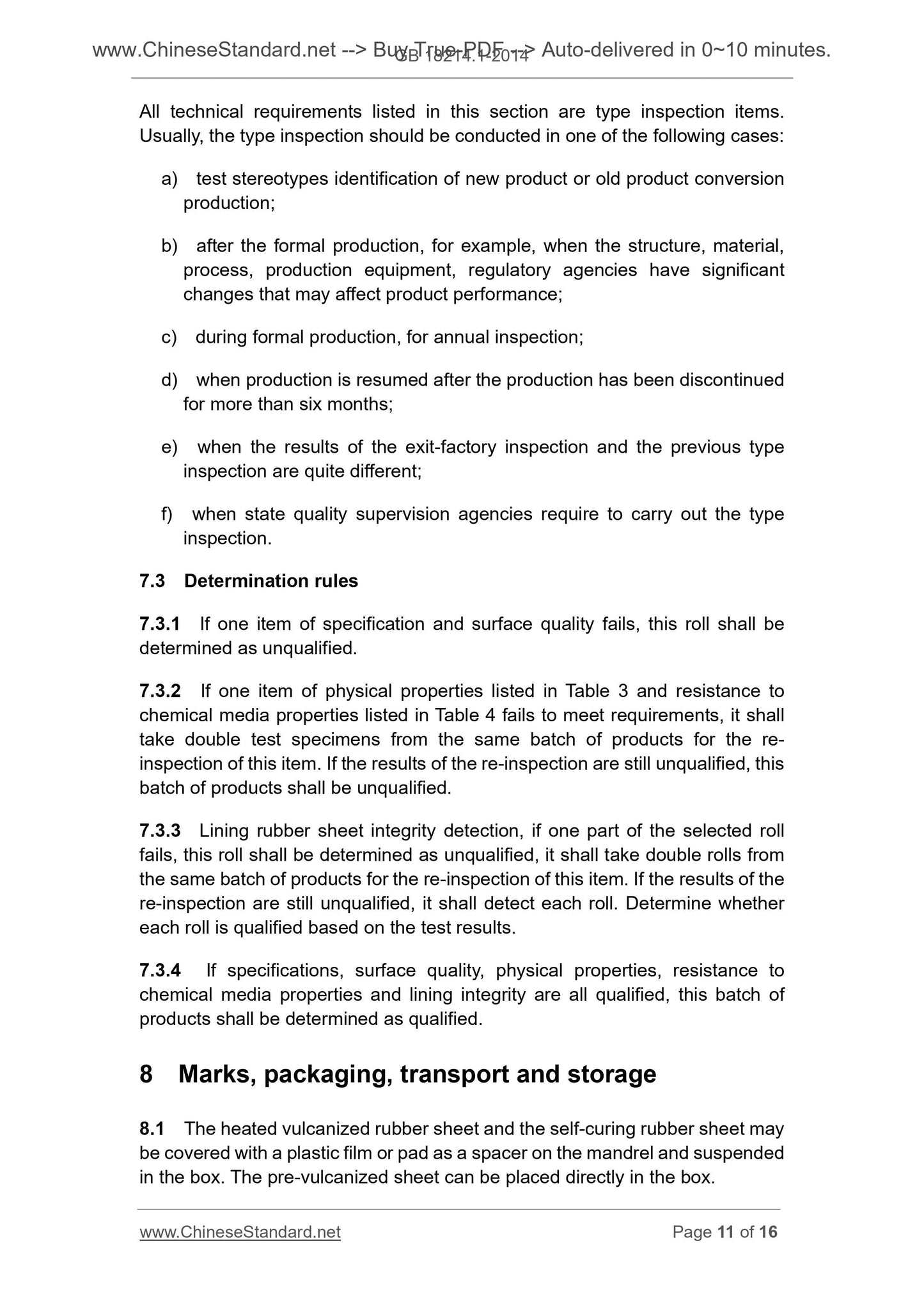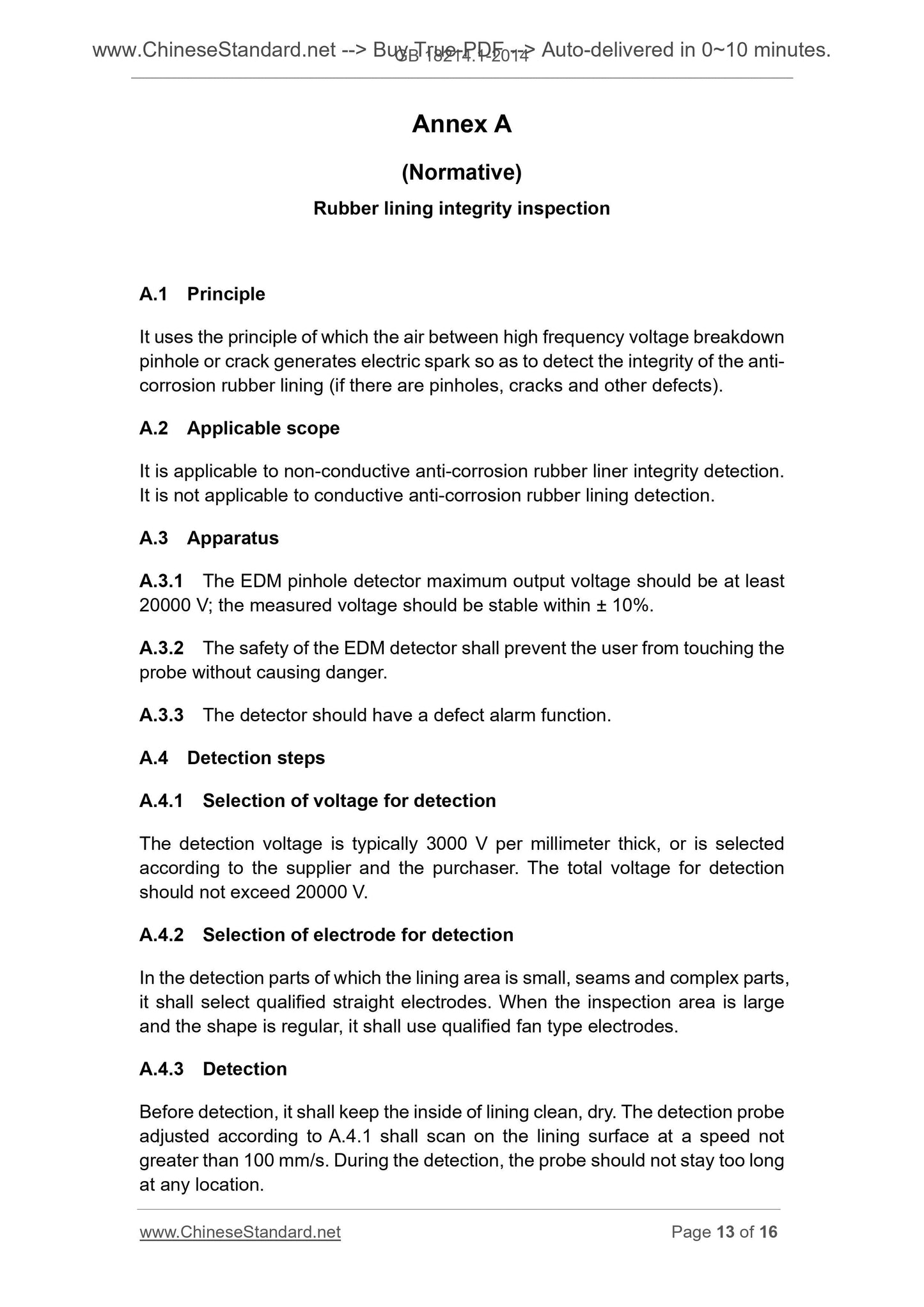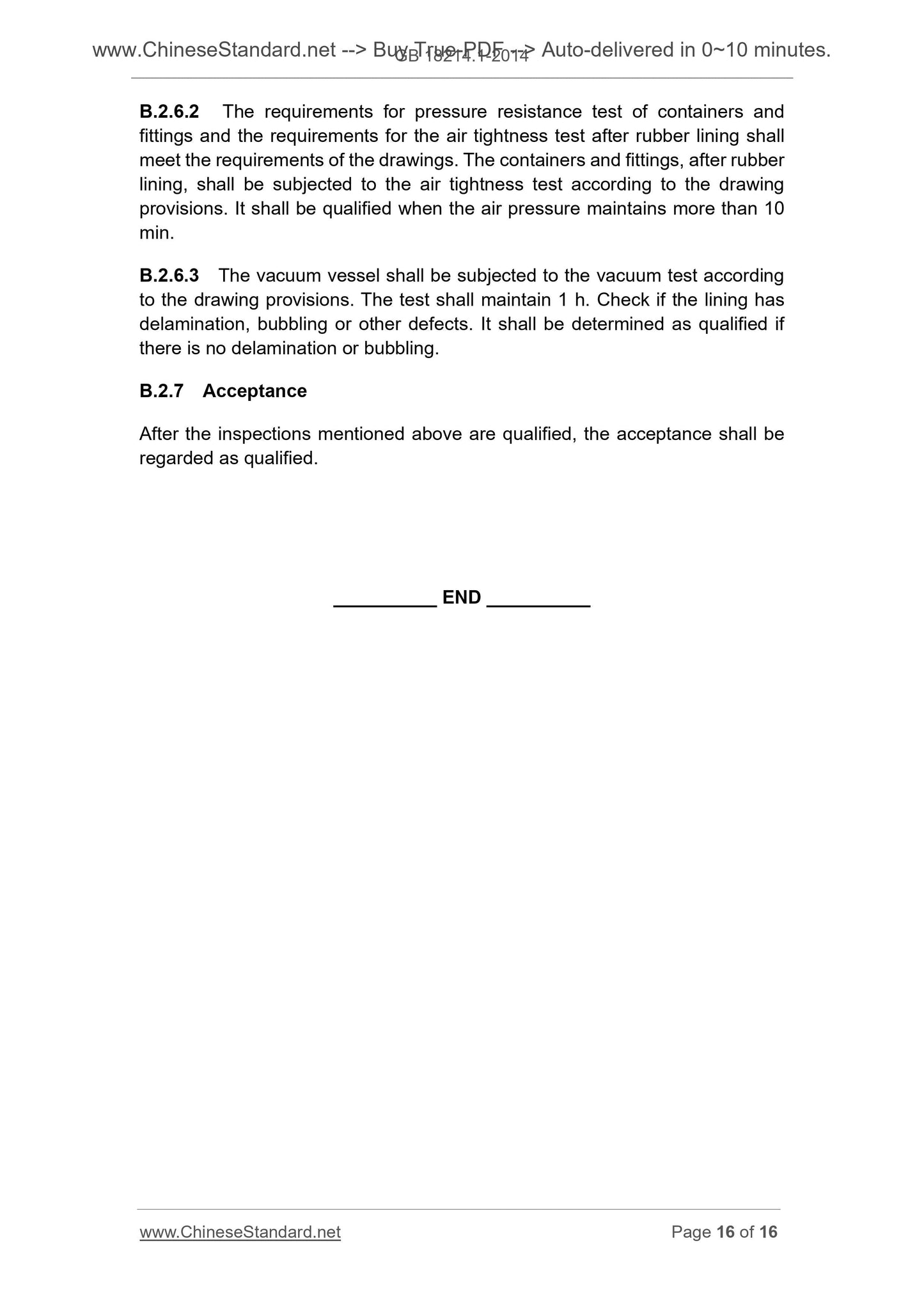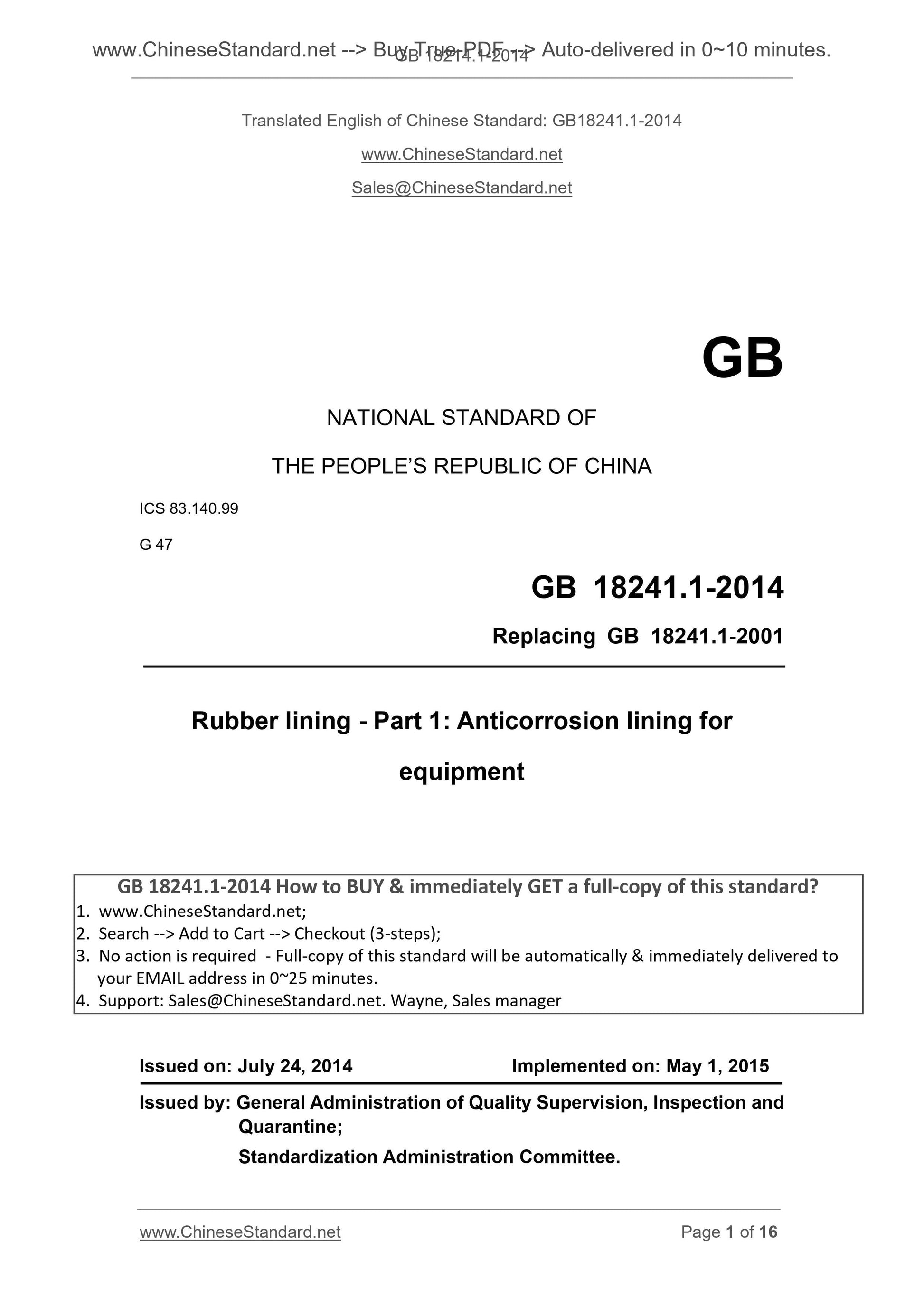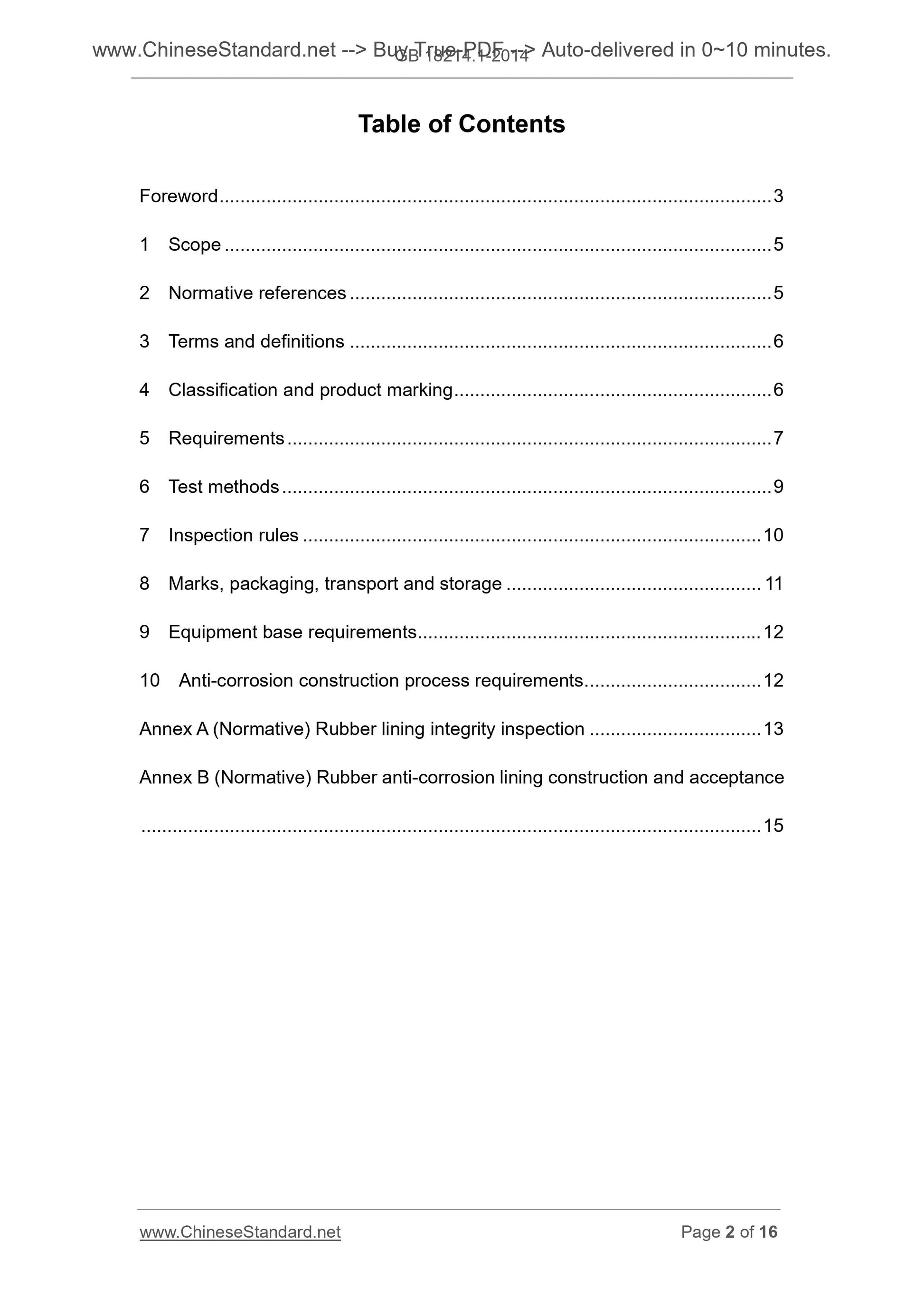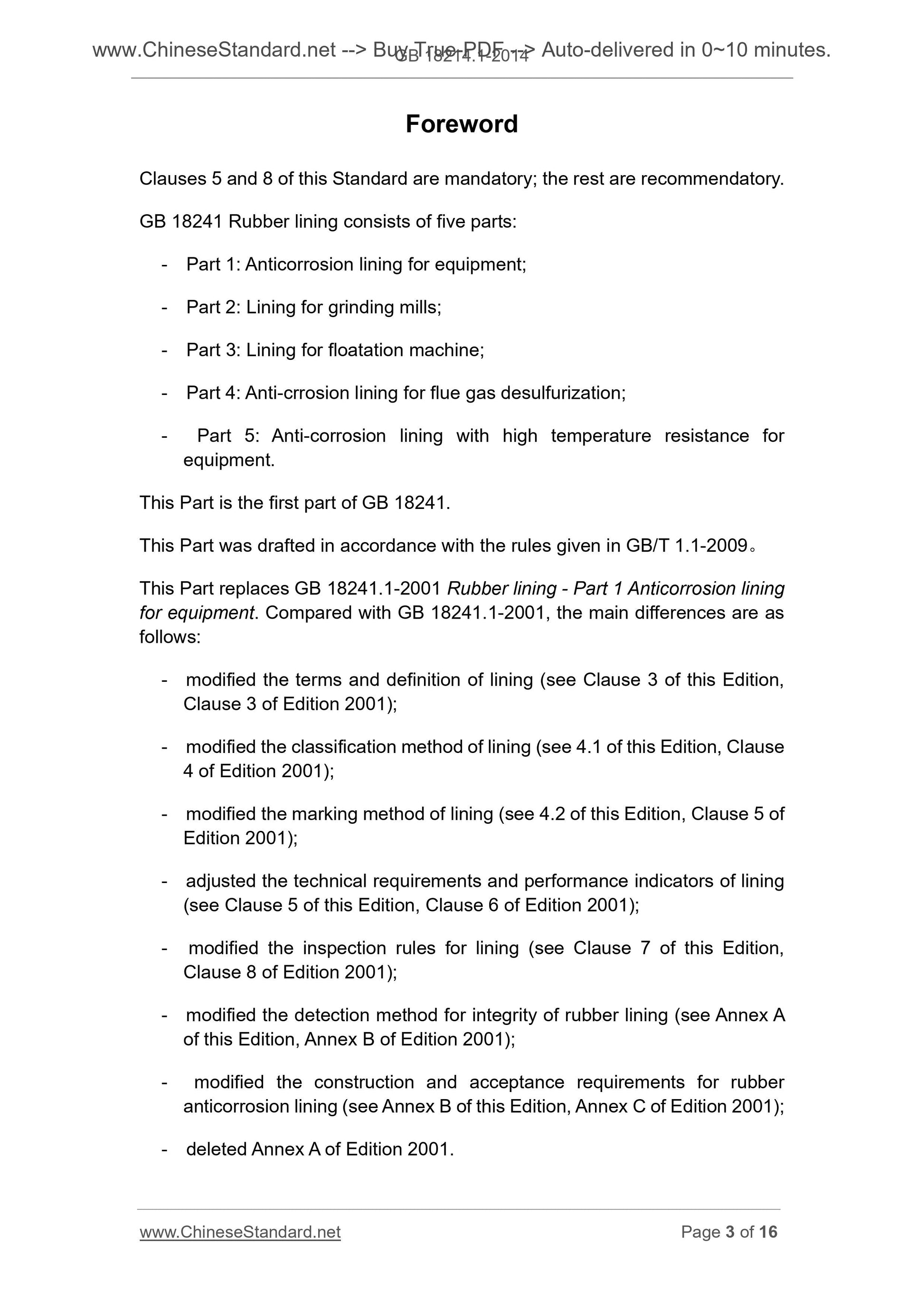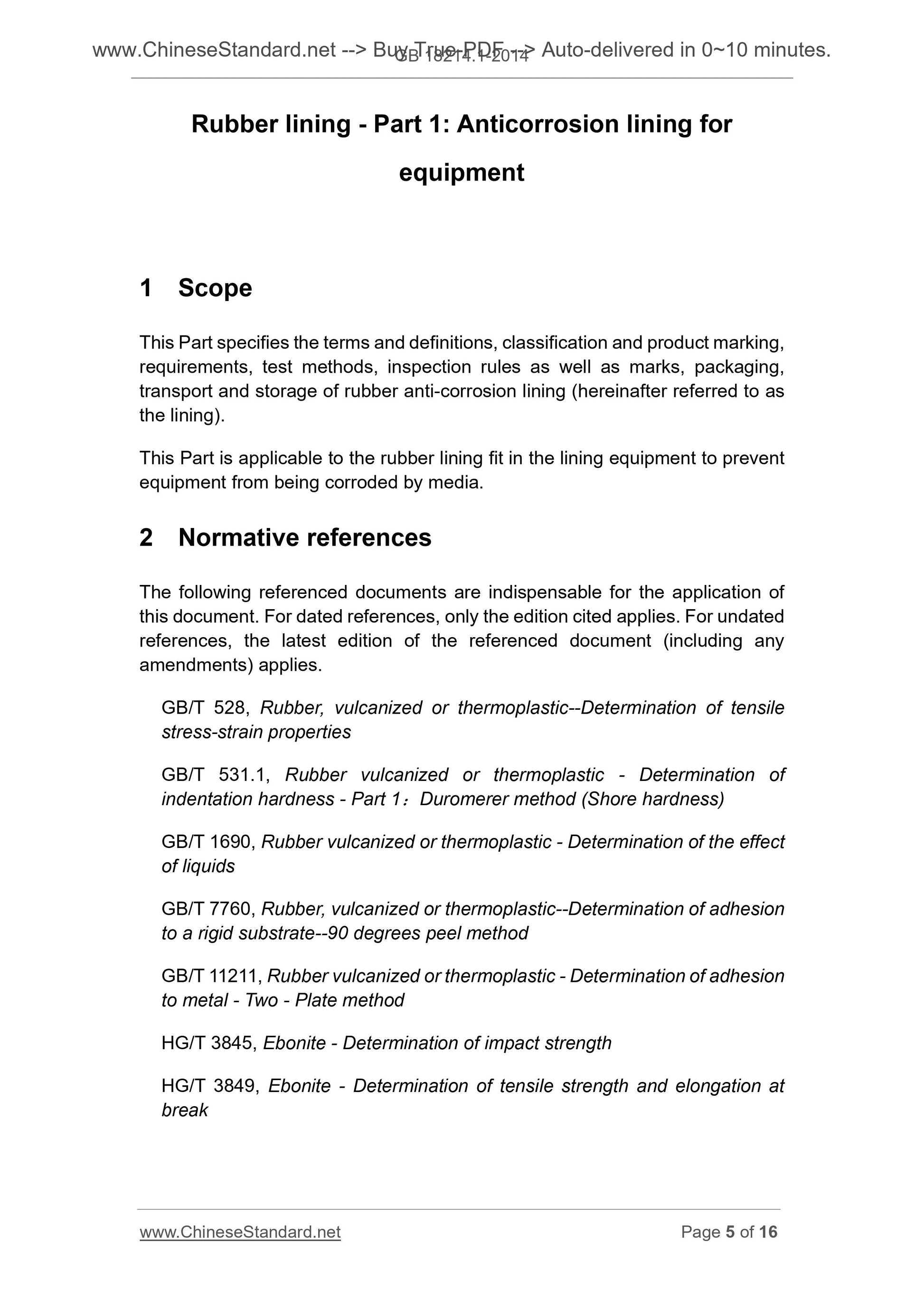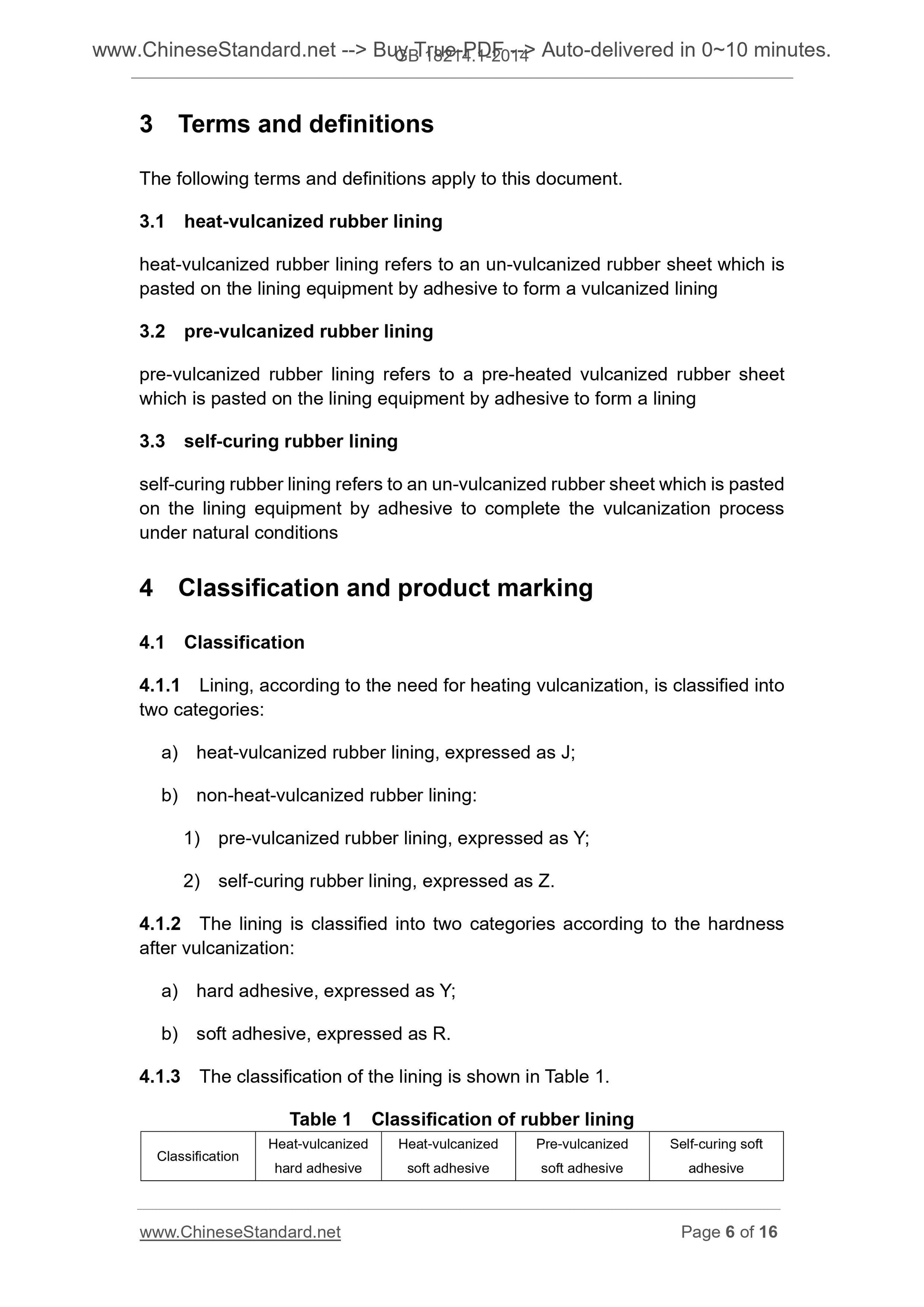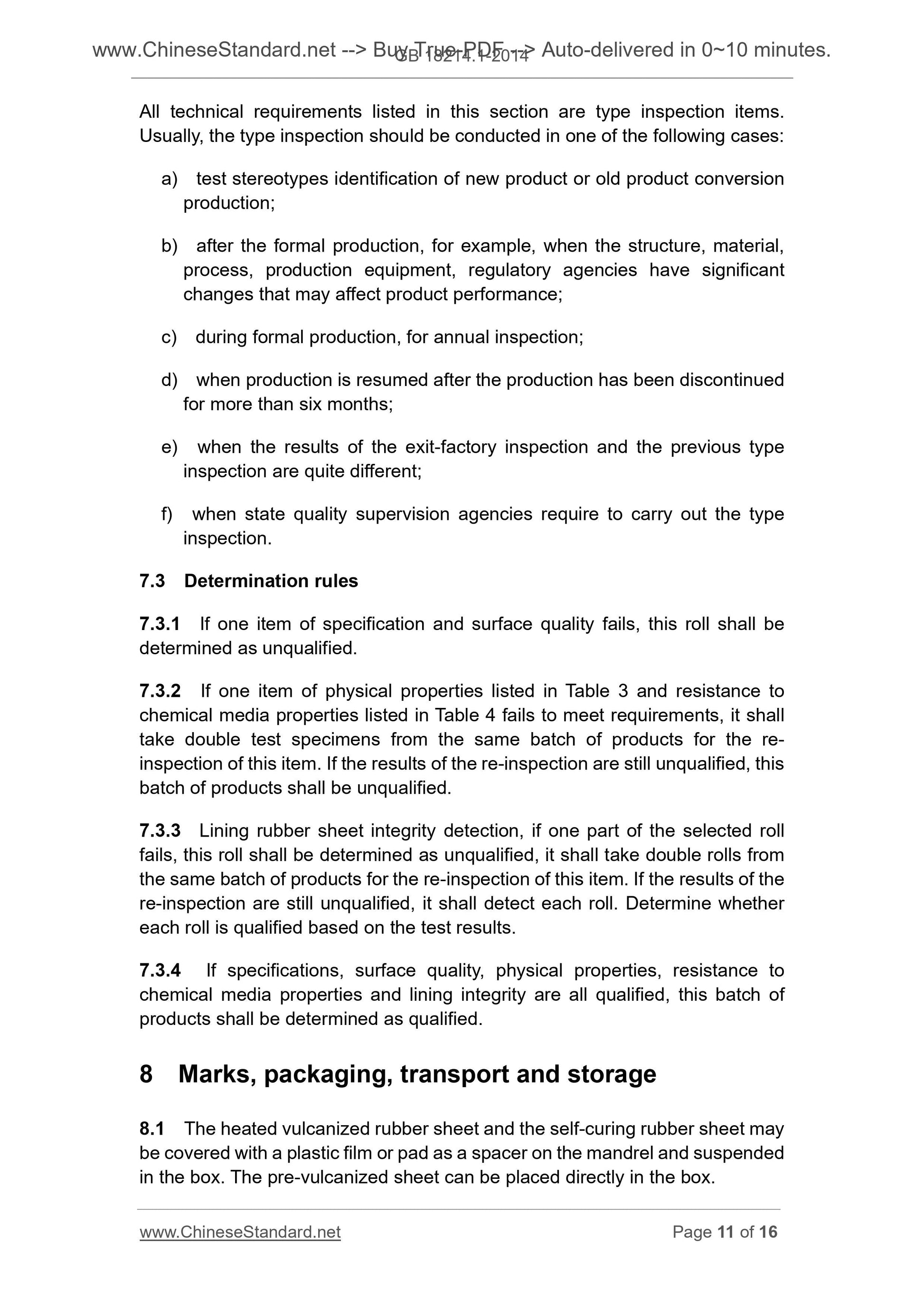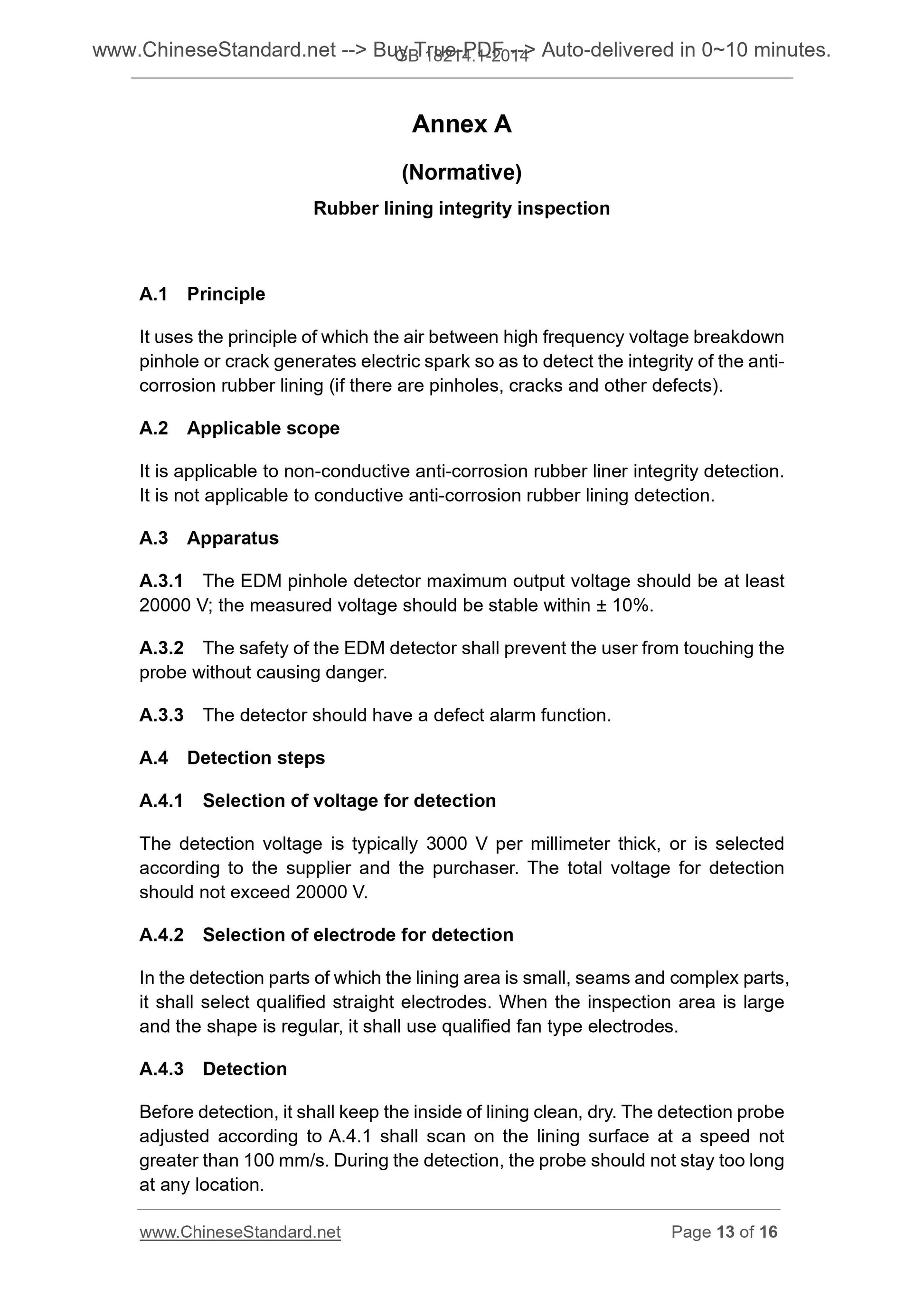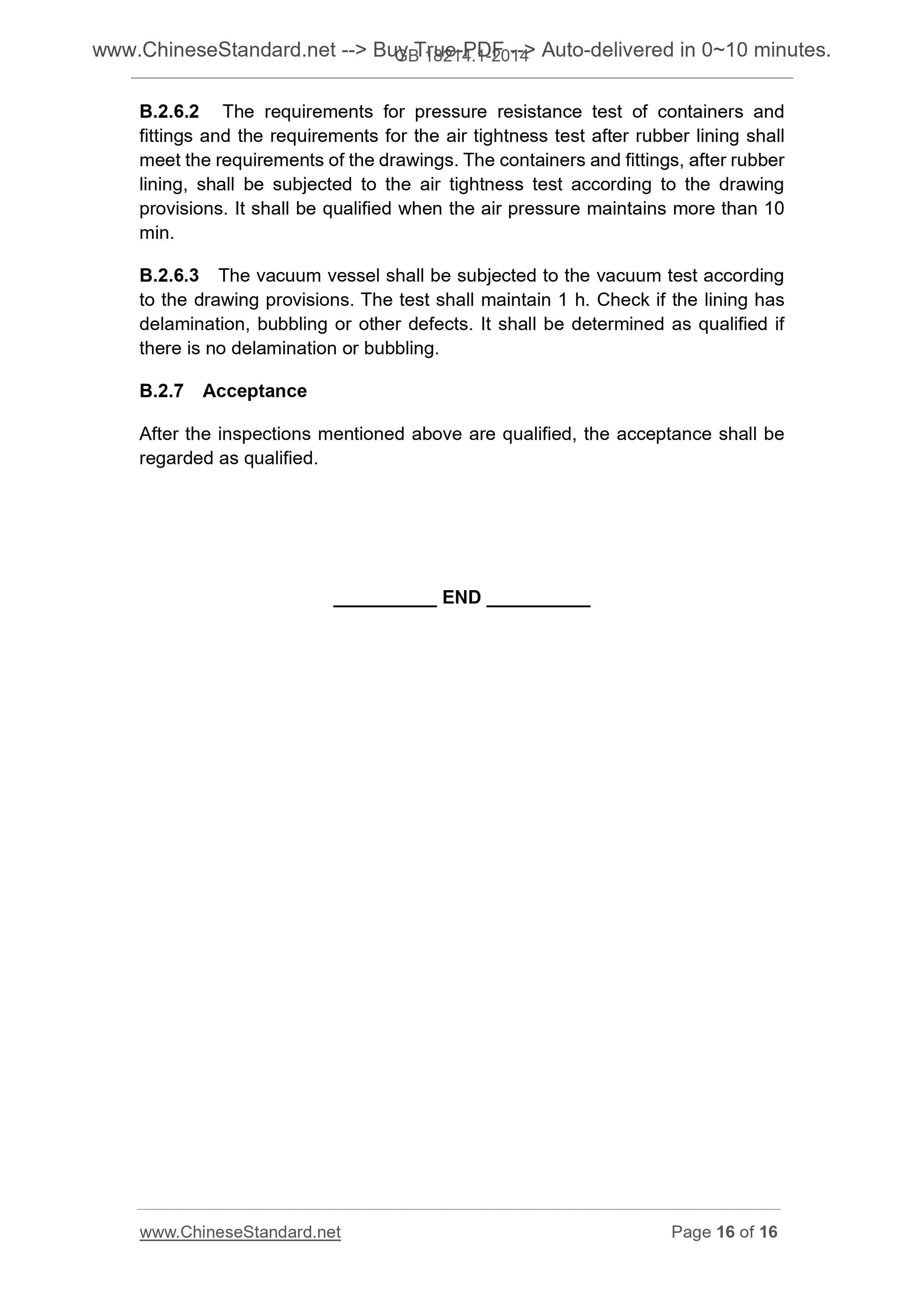1
/
/
8
PayPal, credit cards. Download editable-PDF & invoice in 1 second!
GB 18241.1-2014 English PDF (GB18241.1-2014)
GB 18241.1-2014 English PDF (GB18241.1-2014)
常规价格
$85.00 USD
常规价格
促销价
$85.00 USD
单价
/
单价
结账时计算的运费。
无法加载取货服务可用情况
Delivery: 3 seconds. Download true-PDF + Invoice.
Get QUOTATION in 1-minute: Click GB 18241.1-2014
Historical versions: GB 18241.1-2014
Preview True-PDF (Reload/Scroll if blank)
GB 18241.1-2014: [GB/T 18241.1-2014] Rubber lining -- Part 1: Anticorrosion lining for equipment
GB 18214.1-2014
GB
NATIONAL STANDARD OF
THE PEOPLE’S REPUBLIC OF CHINA
ICS 83.140.99
G 47
Replacing GB 18241.1-2001
Rubber lining - Part 1. Anticorrosion lining for
equipment
ISSUED ON. JULY 24, 2014
IMPLEMENTED ON. MAY 1, 2015
Issued by. General Administration of Quality Supervision, Inspection and
Quarantine;
Standardization Administration Committee.
Table of Contents
Foreword ... 3
1 Scope ... 5
2 Normative references ... 5
3 Terms and definitions ... 6
4 Classification and product marking ... 6
5 Requirements ... 7
6 Test methods ... 9
7 Inspection rules ... 10
8 Marks, packaging, transport and storage ... 11
9 Equipment base requirements ... 12
10 Anti-corrosion construction process requirements ... 12
Annex A (Normative) Rubber lining integrity inspection ... 13
Annex B (Normative) Rubber anti-corrosion lining construction and acceptance
... 15
Foreword
Clauses 5 and 8 of this Standard are mandatory; the rest are recommendatory.
GB 18241 Rubber lining consists of five parts.
- Part 1. Anticorrosion lining for equipment;
- Part 2. Lining for grinding mills;
- Part 3. Lining for floatation machine;
- Part 4. Anti-crrosion lining for flue gas desulfurization;
- Part 5. Anti-corrosion lining with high temperature resistance for
equipment.
This Part is the first part of GB 18241.
This Part was drafted in accordance with the rules given in GB/T 1.1-2009.
This Part replaces GB 18241.1-2001 Rubber lining - Part 1 Anticorrosion lining
for equipment. Compared with GB 18241.1-2001, the main differences are as
follows.
- modified the terms and definition of lining (see Clause 3 of this Edition,
Clause 3 of Edition 2001);
- modified the classification method of lining (see 4.1 of this Edition, Clause
4 of Edition 2001);
- modified the marking method of lining (see 4.2 of this Edition, Clause 5 of
Edition 2001);
- adjusted the technical requirements and performance indicators of lining
(see Clause 5 of this Edition, Clause 6 of Edition 2001);
- modified the inspection rules for lining (see Clause 7 of this Edition,
Clause 8 of Edition 2001);
- modified the detection method for integrity of rubber lining (see Annex A
of this Edition, Annex B of Edition 2001);
- modified the construction and acceptance requirements for rubber
anticorrosion lining (see Annex B of this Edition, Annex C of Edition 2001);
- deleted Annex A of Edition 2001.
Rubber lining - Part 1. Anticorrosion lining for
equipment
1 Scope
This Part specifies the terms and definitions, classification and product marking,
requirements, test methods, inspection rules as well as marks, packaging,
transport and storage of rubber anti-corrosion lining (hereinafter referred to as
the lining).
This Part is applicable to the rubber lining fit in the lining equipment to prevent
equipment from being corroded by media.
2 Normative references
The following referenced documents are indispensable for the application of
this document. For dated references, only the edition cited applies. For undated
references, the latest edition of the referenced document (including any
amendments) applies.
GB/T 528, Rubber, vulcanized or thermoplastic--Determination of tensile
stress-strain properties
GB/T 531.1, Rubber vulcanized or thermoplastic - Determination of
indentation hardness - Part 1. Duromerer method (Shore hardness)
GB/T 1690, Rubber vulcanized or thermoplastic - Determination of the effect
of liquids
GB/T 7760, Rubber, vulcanized or thermoplastic--Determination of adhesion
to a rigid substrate--90 degrees peel method
GB/T 11211, Rubber vulcanized or thermoplastic - Determination of adhesion
to metal - Two - Plate method
HG/T 3845, Ebonite - Determination of impact strength
HG/T 3849, Ebonite - Determination of tensile strength and elongation at
break
3 Terms and definitions
The following terms and definitions apply to this document.
3.1 heat-vulcanized rubber lining
heat-vulcanized rubber lining refers to an un-vulcanized rubber sheet which is
pasted on the lining equipment by adhesive to form a vulcanized lining
3.2 pre-vulcanized rubber lining
pre-vulcanized rubber lining refers to a pre-heated vulcanized rubber sheet
which is pasted on the lining equipment by adhesive to form a lining
3.3 self-curing rubber lining
self-curing rubber lining refers to an un-vulcanized rubber sheet which is pasted
on the lining equipment by adhesive to complete the vulcanization process
under natural conditions
4 Classification and product marking
4.1 Classification
4.1.1 Lining, according to the need for heating vulcanization, is classified into
two categories.
a) heat-vulcanized rubber lining, expressed as J;
b) non-heat-vulcanized rubber lining.
1) pre-vulcanized rubber lining, expressed as Y;
2) self-curing rubber lining, expressed as Z.
4.1.2 The lining is classified into two categories according to the hardness
after vulcanization.
a) hard adhesive, expressed as Y;
b) soft adhesive, expressed as R.
4.1.3 The classification of the lining is shown in Table 1.
Table 1 Classification of rubber lining
Classification Heat-vulcanized hard adhesive
Heat-vulcanized
soft adhesive
Pre-vulcanized
soft adhesive
Self-curing soft
adhesive
All technical requirements listed in this section are type inspection items.
Usually, the type inspection should be conducted in one of the following cases.
a) test stereotypes identification of new product or old product conversion
production;
b) after the formal production, for example, when the structure, material,
process, production equipment, regulatory agencies have significant
changes that may affect product performance;
c) during formal production, for annual inspection;
d) when production is resumed after the production has been discontinued
for more than six months;
e) when the results of the exit-factory inspection and the previous type
inspection are quite different;
f) when state quality supervision agencies require to carry out the type
inspection.
7.3 Determination rules
7.3.1 If one item of specification and surface quality fails, this roll shall be
determined as unqualified.
7.3.2 If one item of physical properties listed in Table 3 and resistance to
chemical media properties listed in Table 4 fails to meet requirements, it shall
take double test specimens from the same batch of products for the re-
inspection of this item. If the results of the re-inspection are still unqualified, this
batch of products shall be unqualified.
7.3.3 Lining rubber sheet integrity detection, if one part of the selected roll
fails, this roll shall be determined as unqualified, it shall take double rolls from
the same batch of products for the re-inspection of this item. If the results of the
re-inspection are still unqualified, it shall detect each roll. Determine whether
each roll is qualified based on the test results.
7.3.4 If specifications, surface quality, physical properties, resistance to
chemical media properties and lining integrity are all qualified, this batch of
products shall be determined as qualified.
8 Marks, packaging, transport and storage
8.1 The heated vulcanized rubber sheet and the self-curing rubber sheet may
be covered with a plastic film or pad as a spacer on the mandrel and suspended
in the box. The pre-vulcanized sheet can b...
Get QUOTATION in 1-minute: Click GB 18241.1-2014
Historical versions: GB 18241.1-2014
Preview True-PDF (Reload/Scroll if blank)
GB 18241.1-2014: [GB/T 18241.1-2014] Rubber lining -- Part 1: Anticorrosion lining for equipment
GB 18214.1-2014
GB
NATIONAL STANDARD OF
THE PEOPLE’S REPUBLIC OF CHINA
ICS 83.140.99
G 47
Replacing GB 18241.1-2001
Rubber lining - Part 1. Anticorrosion lining for
equipment
ISSUED ON. JULY 24, 2014
IMPLEMENTED ON. MAY 1, 2015
Issued by. General Administration of Quality Supervision, Inspection and
Quarantine;
Standardization Administration Committee.
Table of Contents
Foreword ... 3
1 Scope ... 5
2 Normative references ... 5
3 Terms and definitions ... 6
4 Classification and product marking ... 6
5 Requirements ... 7
6 Test methods ... 9
7 Inspection rules ... 10
8 Marks, packaging, transport and storage ... 11
9 Equipment base requirements ... 12
10 Anti-corrosion construction process requirements ... 12
Annex A (Normative) Rubber lining integrity inspection ... 13
Annex B (Normative) Rubber anti-corrosion lining construction and acceptance
... 15
Foreword
Clauses 5 and 8 of this Standard are mandatory; the rest are recommendatory.
GB 18241 Rubber lining consists of five parts.
- Part 1. Anticorrosion lining for equipment;
- Part 2. Lining for grinding mills;
- Part 3. Lining for floatation machine;
- Part 4. Anti-crrosion lining for flue gas desulfurization;
- Part 5. Anti-corrosion lining with high temperature resistance for
equipment.
This Part is the first part of GB 18241.
This Part was drafted in accordance with the rules given in GB/T 1.1-2009.
This Part replaces GB 18241.1-2001 Rubber lining - Part 1 Anticorrosion lining
for equipment. Compared with GB 18241.1-2001, the main differences are as
follows.
- modified the terms and definition of lining (see Clause 3 of this Edition,
Clause 3 of Edition 2001);
- modified the classification method of lining (see 4.1 of this Edition, Clause
4 of Edition 2001);
- modified the marking method of lining (see 4.2 of this Edition, Clause 5 of
Edition 2001);
- adjusted the technical requirements and performance indicators of lining
(see Clause 5 of this Edition, Clause 6 of Edition 2001);
- modified the inspection rules for lining (see Clause 7 of this Edition,
Clause 8 of Edition 2001);
- modified the detection method for integrity of rubber lining (see Annex A
of this Edition, Annex B of Edition 2001);
- modified the construction and acceptance requirements for rubber
anticorrosion lining (see Annex B of this Edition, Annex C of Edition 2001);
- deleted Annex A of Edition 2001.
Rubber lining - Part 1. Anticorrosion lining for
equipment
1 Scope
This Part specifies the terms and definitions, classification and product marking,
requirements, test methods, inspection rules as well as marks, packaging,
transport and storage of rubber anti-corrosion lining (hereinafter referred to as
the lining).
This Part is applicable to the rubber lining fit in the lining equipment to prevent
equipment from being corroded by media.
2 Normative references
The following referenced documents are indispensable for the application of
this document. For dated references, only the edition cited applies. For undated
references, the latest edition of the referenced document (including any
amendments) applies.
GB/T 528, Rubber, vulcanized or thermoplastic--Determination of tensile
stress-strain properties
GB/T 531.1, Rubber vulcanized or thermoplastic - Determination of
indentation hardness - Part 1. Duromerer method (Shore hardness)
GB/T 1690, Rubber vulcanized or thermoplastic - Determination of the effect
of liquids
GB/T 7760, Rubber, vulcanized or thermoplastic--Determination of adhesion
to a rigid substrate--90 degrees peel method
GB/T 11211, Rubber vulcanized or thermoplastic - Determination of adhesion
to metal - Two - Plate method
HG/T 3845, Ebonite - Determination of impact strength
HG/T 3849, Ebonite - Determination of tensile strength and elongation at
break
3 Terms and definitions
The following terms and definitions apply to this document.
3.1 heat-vulcanized rubber lining
heat-vulcanized rubber lining refers to an un-vulcanized rubber sheet which is
pasted on the lining equipment by adhesive to form a vulcanized lining
3.2 pre-vulcanized rubber lining
pre-vulcanized rubber lining refers to a pre-heated vulcanized rubber sheet
which is pasted on the lining equipment by adhesive to form a lining
3.3 self-curing rubber lining
self-curing rubber lining refers to an un-vulcanized rubber sheet which is pasted
on the lining equipment by adhesive to complete the vulcanization process
under natural conditions
4 Classification and product marking
4.1 Classification
4.1.1 Lining, according to the need for heating vulcanization, is classified into
two categories.
a) heat-vulcanized rubber lining, expressed as J;
b) non-heat-vulcanized rubber lining.
1) pre-vulcanized rubber lining, expressed as Y;
2) self-curing rubber lining, expressed as Z.
4.1.2 The lining is classified into two categories according to the hardness
after vulcanization.
a) hard adhesive, expressed as Y;
b) soft adhesive, expressed as R.
4.1.3 The classification of the lining is shown in Table 1.
Table 1 Classification of rubber lining
Classification Heat-vulcanized hard adhesive
Heat-vulcanized
soft adhesive
Pre-vulcanized
soft adhesive
Self-curing soft
adhesive
All technical requirements listed in this section are type inspection items.
Usually, the type inspection should be conducted in one of the following cases.
a) test stereotypes identification of new product or old product conversion
production;
b) after the formal production, for example, when the structure, material,
process, production equipment, regulatory agencies have significant
changes that may affect product performance;
c) during formal production, for annual inspection;
d) when production is resumed after the production has been discontinued
for more than six months;
e) when the results of the exit-factory inspection and the previous type
inspection are quite different;
f) when state quality supervision agencies require to carry out the type
inspection.
7.3 Determination rules
7.3.1 If one item of specification and surface quality fails, this roll shall be
determined as unqualified.
7.3.2 If one item of physical properties listed in Table 3 and resistance to
chemical media properties listed in Table 4 fails to meet requirements, it shall
take double test specimens from the same batch of products for the re-
inspection of this item. If the results of the re-inspection are still unqualified, this
batch of products shall be unqualified.
7.3.3 Lining rubber sheet integrity detection, if one part of the selected roll
fails, this roll shall be determined as unqualified, it shall take double rolls from
the same batch of products for the re-inspection of this item. If the results of the
re-inspection are still unqualified, it shall detect each roll. Determine whether
each roll is qualified based on the test results.
7.3.4 If specifications, surface quality, physical properties, resistance to
chemical media properties and lining integrity are all qualified, this batch of
products shall be determined as qualified.
8 Marks, packaging, transport and storage
8.1 The heated vulcanized rubber sheet and the self-curing rubber sheet may
be covered with a plastic film or pad as a spacer on the mandrel and suspended
in the box. The pre-vulcanized sheet can b...
Share
